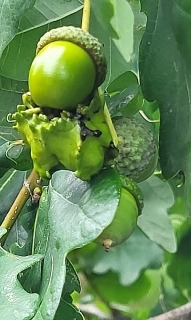Adam Yamey's Blog: YAMEY, page 7
August 2, 2025
A great exhibition of the works of a British artist
UNTIL I ATTENDED the superb display of the paintings of Edward Burra (1905-1976) at a special exhibition at London’s Tate Britain, I associated him only with depictions of the USA. Despite his Italian sounding surname, Burra’s father came from a long-established British family. Edward trained as an artist at Chelsea School of Art, then at the Royal College of Art. In 1925, he contracted rheumatic fever, and for the rest of his life he suffered ill-health. However, this does not seem to have affected his ability to produce an impressive number of beautiful paintings.
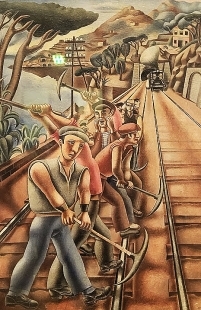
The exhibition at Tate Britain displays Burra’s paintings and drawings chronologically. Throughout his life, he produced works of art that are not only attractive and intriguing but also sensitive portrayals of his views of the times in which he lived. Some paintings exhibit his interest in surrealism, but although many of his paintings have a dreamlike quality, they are in the main not what could be described as Surrealist. His images of France, although highly original and imaginative, capture the ‘atmosphere’ of French life between the two World Wars. Burra was keen on jazz. Many of his paintings include jazz musicians, particularly those he made while visiting the USA, and New York City in particular. The exhibition includes a collection of some of the artist’s collection of jazz music records.
Burra lived through two World Wars and the Spanish Civil War. The Tate’s exhibition includes many of his paintings depicting the horrors of these conflicts. The final room of the show displays Burra’s portrayals of Britain. The artist’s depictions of landscapes is stylistically original, slightly abstracted, but evokes their nature perfectly.
Whether Burra is painting people or objects or machinery or landscapes, the impact of his painting is in each case powerful. This wonderful exhibition will continue until 19 October 2025, and is well worth seeing. I am glad I went because now I realise that although his paintings of New York and jazz are wonderful, they are only a fraction of Burra’s amazingly artistic output.
August 1, 2025
Numbered pebbles to remember the dead in Folkestone
ON THE FIRST of July 1916, 19 thousand two hundred and forty British soldiers were killed during the first day of the Battle of the Somme. A memorial on the Leas Cliff promenade in Folkestone, Kent, remembers them, not by name but by number.
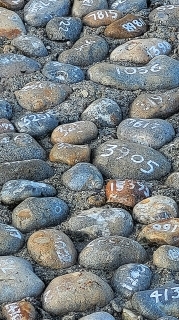
In 2008, the artist Mark Wallinger created an artwork called “Folk Stones”, which can be viewed at Leas Cliff. It consists of a square area containing 19,240 pebbles. Each one represents one of the victims killed on that first day of battle in 1916. Just as each of the soldiers had his own service number, the artist has numbered each of the stones in his artwork.
It is a simple creation, but one that is very moving.
July 31, 2025
Small beginnings
July 30, 2025
In the pink for cod’s sake
IN THE LATE 1960s, my mother used to buy taramasalata from the two Greek Cypriot shops that used to be in London’s Goodge Street area: one was in Charlotte Street, the other in Goodge Street. Taramasalata is a pink* paste made with fish roe (‘taramas’ in Greek; ‘tarama’ in Turkish). I still enjoy eating the stuff. Typically, good taramasalata contains about 8 to 10 % cod’s roe by weight and other ingredients. When my mother discovered that most of the bulk of the taramasalata was bread, she felt swindled. She felt that it was unfair to describe taramasalata as a fish paste when most of what was in the container was bread. It was, she felt, an expensive way to purchase soggy bread.

So, one day she decided that she would make her own taramasalata, and hers, unlike that which she had purchased from the Greek Cypriot shops, would be unadulterated with bread. Her version omitted the bread. The result was so incredibly salty that it was inedible. What she had demonstrated was that the traditional way to prepare this fishy dip using bread was not a load of ‘codswallop’.
[* There is also a white version]
July 29, 2025
Bungalows of historical interest in Birchington (Kent)
DURING OUR RECENT visit to east Kent, we spent two nights in a bed and breakfast (‘B&B’) on Spencer Road at Birchington. Despite visibility being restricted by torrential rain when we arrived at the accommodation, I was able to see that there was an attractive sgraffito frieze around the house at the level of the first floor. Even in the poor light, I could make out that frieze was created in the Arts and Crafts Style, which was popular in the last quarter of the nineteenth and first quarter of the twentieth centuries. Our B&B was called The Old Coach House, and I will explain why soon.
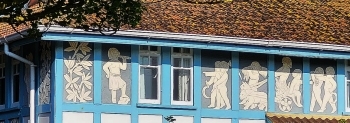
Visitors to English coastal towns will have seen the huge numbers of bungalows (single-storey dwellings) that they contain. What many people might not know is that “… England’s first bungalow was built in Westgate in 1867” (www.birchingtonheritage.org.uk/articles/bungalows.htm). Birchington, which is a few miles from Westgate was home to the country’s first bungalow estate. This comprises five bungalows, each with its own watch tower. They are next to Coleman Stairs, which is a steep path leading down from the clifftop to the seashore. The bungalows, close to the cliff edge, were ready for use in 1880 and are accessed via a private lane from Spenser Road.
Each of the bungalows was provided with its own coach house, which accommodated the householder’s servants, carriages, and horses. Our B&B was one of the coach houses. It has been converted into a residence. Our first-floor bedroom would have once been one of the servant’s rooms. A small staircase leads from the ground to the first floor. This was added long after the building ceased to be a coach house. Before this was added, the servants accessed the first floor by an outside staircase, which no longer exists,
The sgraffito friezes on each of the three former stable blocks that we saw are in good condition. The coach houses were built in about 1882 and designed by John Pollard Seddon (1827-1906), who was closely associated with the Pre-Raphaelite group of artists. The sgraffito work on the coach housed is said to have been created by the sculptor George Frampton (1860-1928), whose other works include the Peter Pan statue in Kensington Gardens and a statue of Queen Victoria in the grounds of the Victoria Memorial in Kolkata. An article published in the Thanet Times in the 1970s revealed:
“Frampton as a youth was a friend of the artist Solomon J. Solomon, a well known artist of his day, who had bought the annex, “The Porch,” in Spencer Road, Birchington, which was the coach house to his main house called “Whitecliff” – one of the famous Tower Bungalows. George Frampton came to live with the Solomon’s when he was a penniless sculptor, fresh from years of apprenticeship to his profession. Solomon wanted to help Frampton and suggested that he might create frescoes round the upper part of his new house. Frampton made this a labour of love. He was 22 years old at the time – 1882 ,,, But the name of his benefactor is almost forgotten – but not Frampton’s frescoes.” (www.birchingtonheritage.org.uk/)
When we booked the B&B, we had no inkling of its historical interest. We had a comfortable stay there, and were well looked after by Tim, our friendly host. His affectionate dog Louie added to our enjoyment of the place.
July 28, 2025
From Cairo to Kent and Karl Marx
IN RECENT YEARS, the seaside town of Margate in Kent has become much more of a “trendy” destination than it used to be. From being yet another coastal resort, it has become a magnet for those interested in contemporary art. This is because of the presence of the Turner Contemporary Gallery, Tracey Emins’s gallery, and the Carl Freedman gallery … to mention but a few places. With the influx of tourists with sophisticated tastes, the town has become home to a range of restaurants, which is more varied than in many other seaside towns in north and east Kent.
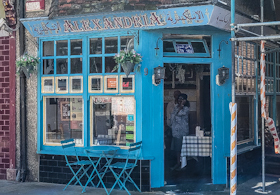
About 6 years ago, a husband and wife from Cairo (Egypt) set up a tiny restaurant on a corner plot in the old centre of Margate. It is called Alexandria Café. The owners chose the name not because they come from Alexandria, but because like the Egyptian city, Margate is by the sea.
Only open on Fridays, Saturdays, and Sundays at present, this restaurant serves beautifully prepared, tasty Egyptian dishes at very reasonable prices. We tried koshari, falafel, baba ganush, pickled tomato salad, and mint tea. Although these are all without meat, non-veg dishes are also available.
The tiny, comfortable eatery is decorated with photographs of Egyptian film stars. A small television screen was showing old Egyptian films.
A few doors away from the lovely Egyptian cafe, there is an ice cream parlour. What makes it special is that in 1866, Karl Marx stayed in the building.
We did not try the ice cream, but I can safely say that of all the places I have eaten in Margate, having visited the place many times, Alexandria is the best.
July 27, 2025
Coffee in a railway signal cabin
THE TRAINS THAT used to run into Folkestone Harbour station have not done so for many years. The station has been restored and repurposed as a pleasant, tasteful leisure amenity.
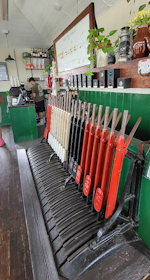
The signal box that used to regulate rail traffic in and out of the station still stands. It is now used as a café. With fine views of the harbour and Folkestone town, the signal box now contains equipment for making coffees and seats for customers. Apart from being an interesting old building, the old signal box contains the levers that used to operate the points within the station and on the bridge across the small harbour that connects it to the main land.
The café is not only housed in an original building, but also the coffee made there is above average in quality.
July 26, 2025
The spirit of entente cordiale in Folkestone ???
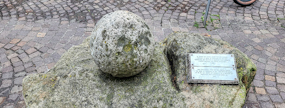
This stone cannon ball was fired by the English at the siege of Boulogne in 1544. It was returned to England by the people of Boulogne as a gesture of friendship in 1976.
July 25, 2025
The station where Gandhi landed in England in 1931
WHEN MAHATMA GANDHI came to England in 1931, he disembarked at Folkestone in Kent. In those days there boats docked alongside a pier, and then boarded trains at a station on the pier. The pier has long since ceased to be used to service cross channel and other passenger boats, but it and the station have been preserved and converted into a tasteful leisure amenity.
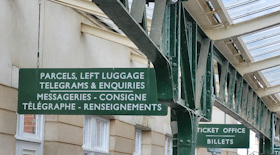
A more detailed history of the pier and its station is available here: https://gujarat-travels.com/2021/10/24/where-mahatma-gandhi-set-foot-in-england-in-1931/
July 24, 2025
A bird of the sea on wheels in Folkestone
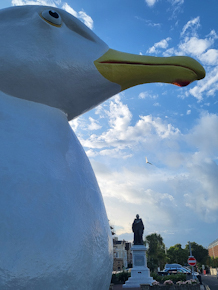
THE MOBILE GULL APPRECIATION UNIT was created by Mark Dion in 2008 for the 2008 Creative Folkestone Triennial. On wheels, this enormous model of a seagull can be towed to different locations. The seagull can be entered and is used by people trying to persuade viewers to understand and appreciate gulls, which are often regarded as pests. Personally, I have nothing against these creatures.
Folkestone in Kent has become a town filled with art works. Every 3 years it hold an art festival, the Folkestone Triennale. This year it began two days ago. This is one of the permanent works.

